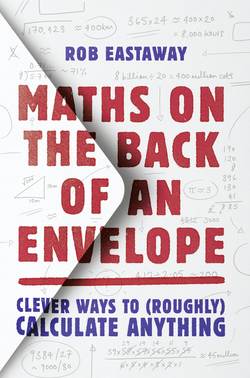Читать книгу Maths on the Back of an Envelope: Clever ways to (roughly) calculate anything - Rob Eastaway - Страница 5
PROLOGUE HOW MANY CATS?
ОглавлениеA few years ago, at a school event, I asked the audience of teenagers to submit some estimation questions that I would then attempt to answer live on stage. One pupil posed this simple question: ‘How many cats are there in the world?’
Cats are always a popular topic, so I took it on.
My thinking went like this:
Let’s assume that most cats are domestic.
Some people have more than one cat, but usually a household has only one cat, if any at all.
In the UK, and thinking of my own street as an example, it seems reasonable to suppose that there might be one cat in every five households.
And, if a household contains on average two people, that means there is one cat for every 10 people.
So, with 70 million people in the UK, let’s say that there are, perhaps, seven million cats in the UK.
So far, so good. But what about the number of cats in the rest of the world? It seems unlikely that cats are as popular in countries like India or China as they are in the UK (although what would I know? Remember, this is purely guesswork on my part), therefore, I’d expect the ratio across the world to be smaller than it is in the UK – maybe one cat for every 20 people?
So, with eight billion people in the world, that suggests there are maybe:
8 billion ÷ 20 = 400 million cats.
It doesn’t seem an outrageous number.
That was the figure I suggested, anyway.
A member of the audience put his hand up.
‘The real number is 600 million,’ he said.
‘Really – how do you know?’
‘I just looked it up online.’
So that’s it: no need to come up with an answer; it’s already been done.
If it’s really that simple, we can forget about doing estimations altogether. With just a few clicks on Google you will probably find a statistic to answer every question you could possibly think of.
Except for one crucial thing.
Where did the person who published that figure of 600 million online get their number from? No one, I’m quite sure, has gone around the world doing a census of cats. The figure of 600 million is an estimate. It might be an estimate that is based on a slightly more scientific method than mine, using rigorous surveys and cross-checks, but it’s just as likely that the figure cited online came from somebody who did a back-of-envelope calculation like the one I just described. Or, perhaps they simply invented a figure that suited their agenda. There’s no reason to believe that their number is more reliable than mine – indeed, it might be less reliable.
Once a statistic like this is out there, published in a newspaper, quoted on a website, it becomes ‘fact’, and it can be re-quoted so often that the source may go unquestioned and very quickly be forgotten altogether.
It’s an important reminder that the majority of statistics published anywhere are estimates, many of them worked out on the equivalent of the back of an envelope. When back-of-envelope calculations produce a very different answer from the one that’s been put forward, it doesn’t necessarily mean that the estimate is wrong. It means rather that the published figure deserves more scrutiny.
We tend to think of maths as being an ‘exact’ discipline, where answers are right or wrong. And it’s true that there is a huge part of maths that is about exactness.
But in everyday life, numerical answers are sometimes just the start of the debate. If we are trained to believe that every numerical question has a definitive, ‘right’ answer then we miss the fact that numbers in the real world are a lot fuzzier than pure maths might suggest.
I’ve realised in writing this book that there is a kind of paradox. On the one hand, I want to argue that approximate numbers can often be more informative, and more trustworthy, than precise numbers. Yet at the same time, in order to be able to produce those approximate answers, it’s essential to know how to do some calculations exactly. Your basic times tables, for example. Concrete, exact maths is the foundation for the woolly numbers that we have to deal with in everyday life.
I’ve divided the book into four sections.
In the first section, I explore how precise numbers can be misleading, and why it’s good not to be entirely dependent on a calculator.
The second section includes the arithmetical techniques and the other knowledge that is an essential foundation if you want to embark on back-of-envelope calculations. This includes a refresher on how to do arithmetic that you may not have needed to practise since you left primary school, as well as short cuts that you probably never encountered there.
The rest of the book shows how to use these techniques to tackle problems, from everyday conversions, to more serious issues like helping the environment. And at the end, there is a collection of so-called Fermi questions: quirky and esoteric challenges to come up with a reasonable answer based on very little hard data.
Back-of-envelope maths is an important and valuable life skill. But that’s not its only benefit. Many of us also indulge in it simply because it’s a fun and stimulating exercise that keeps the brain sharp.
